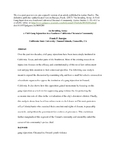- DSpace Home
- →
- Channel Islands
- →
- Academic Affairs
- →
- Faculty Scholarly and Creative Activities
- →
- Barajas, Frank
JavaScript is disabled for your browser. Some features of this site may not work without it.
| dc.date.accessioned | 2010-01-12T19:41:13Z | en |
| dc.date.accessioned | 2010-01-12T19:41:13Z | en |
| dc.date.available | 2010-01-12T19:41:13Z | en |
| dc.date.available | 2010-01-12T19:41:13Z | en |
| dc.date.issued | 2007-01 | en |
| dc.date.issued | 2007-01 | en |
| dc.identifier.citation | Barajas, Frank. (2007) “An Invading Army: A Civil Gang Injunction in a Southern California Chicana/o Community. Latino Studies 5: 393-417 | en |
| dc.identifier.citation | Barajas, Frank. (2007) “An Invading Army: A Civil Gang Injunction in a Southern California Chicana/o Community. Latino Studies 5: 393-417 | en |
| dc.identifier.issn | 1476-3435 | en |
| dc.identifier.issn | 1476-3435 | en |
| dc.identifier.uri | http://hdl.handle.net/10139/792 | en |
| dc.identifier.uri | http://hdl.handle.net/10139/792 | en |
| dc.description.abstract | Over the past two decades, civil gang injunctions have been increasingly instituted in California, Texas, and other parts of the Southwest. Most of the existing research on injunctions focuses on the efficacy and constitutionality of this novel law enforcement tool and pay little attention to their contextual specifics. The following case study is meant to expand the discussion by examining why and how a small but eclectic crosssection of residents organized to oppose the institution of a gang injunction in Oxnard, California. It also shows how this opposition gained momentum by focusing on this gang injunction as a tool not for suppressing gang violence but for protecting the economic interests of elites in the revitalization of the city’s downtown district. Finally, this analysis shows how local law enforcement cracked down on Chicana/o protesters of La Colonia barrio who exercised their constitutional rights of dissent, to peaceably assemble, and petition the government for a redress of grievances. This crackdown further marginalized this segment of the Oxnard community and ostensibly ended the career of this community’s police chief. | en |
| dc.description.abstract | Over the past two decades, civil gang injunctions have been increasingly instituted in California, Texas, and other parts of the Southwest. Most of the existing research on injunctions focuses on the efficacy and constitutionality of this novel law enforcement tool and pay little attention to their contextual specifics. The following case study is meant to expand the discussion by examining why and how a small but eclectic crosssection of residents organized to oppose the institution of a gang injunction in Oxnard, California. It also shows how this opposition gained momentum by focusing on this gang injunction as a tool not for suppressing gang violence but for protecting the economic interests of elites in the revitalization of the city’s downtown district. Finally, this analysis shows how local law enforcement cracked down on Chicana/o protesters of La Colonia barrio who exercised their constitutional rights of dissent, to peaceably assemble, and petition the government for a redress of grievances. This crackdown further marginalized this segment of the Oxnard community and ostensibly ended the career of this community’s police chief. | en |
| dc.language.iso | en_US | en |
| dc.language.iso | en_US | en |
| dc.publisher | Palgrave | en |
| dc.publisher | Palgrave | en |
| dc.subject | gang injunction | en |
| dc.subject | Chicanas | en |
| dc.subject | Chicanos | en |
| dc.subject | Oxnard | en |
| dc.subject | youth violence | en |
| dc.subject | gang injunction | en |
| dc.subject | Chicanas | en |
| dc.subject | Chicanos | en |
| dc.subject | Oxnard | en |
| dc.subject | youth violence | en |
| dc.title | An Invading Army: A Civil Gang Injunction in a Southern California Chicana/o Community | en |
| dc.title | An Invading Army: A Civil Gang Injunction in a Southern California Chicana/o Community | en |
| dc.type | Postprint | en |
| dc.type | Postprint | en |
| dc.contributor.csuciauthor | Barajas, Frank P. | en |
| dc.contributor.csuciauthor | Barajas, Frank P. | en |
Files in this item
The following license files are associated with this item:
This item appears in the following Collection(s)
-
Barajas, Frank [1]

